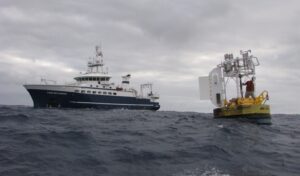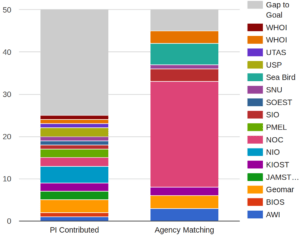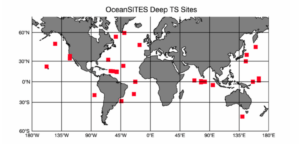Early on, POGO established a WG focusing on fixed point time-series stations, and on the establishment of a network of open-ocean, fixed-point, time-series observations. This was very much seen as a complement to the Argo programme, and the POGO members agreed to collectively support the network of deep-ocean time-series stations that would later become known as OceanSITES.
Bob Weller, who was a member of the Time Series WG, and for many years a representative of OceanSITES within POGO, provides some recollections of his time in POGO and of how POGO helped support international cooperation and the establishment and long-term success of OceanSITES. Read more…
Long-term time series sites and international cooperation
(R. Weller, 6/25/2020)

POGO has been a strong supporter of the collection of long-term time series from the ocean and helped support the international OceanSITES group. One of the long-term sites is the Stratus Ocean Reference Station (ORS) that I maintain off northern Chile (20°S, 85°W) with funding from NOAA. The Stratus ORS was first deployed in October 2000 about 1500 km westward off northern Chile. The well-instrumented surface buoy carries meteorological sensors and provides the data to produce climate quality air-sea fluxes of heat, freshwater, and momentum. The mooring line below carries temperature salinity, velocity, and dissolved oxygen sensors. Every other year, sensors from colleagues at GEOMAR in Kiel, Germany increase the sampling of dissolved oxygen. More information and data are available online at http://uop.whoi.edu.
Over the years we have engaged our colleagues in Chile. From the beginning we had help from colleagues at the Universidad de Concepcion UdeC), who accompanied us to initial meetings with the SERVICIO HIDROGRÁFICO Y OCEANOGRÁFICO DE LA ARMADA (SHOA) and helped us work out how to stage cruises and work out of Chilean ports. Over the years, we went to sea with students from the UdeC and the Universidad de Chile, Santiago. Staff from SHOA joined us on a number of the cruises. SHOA helped us instrument their DART buoy to collect additional data during the CLIVAR VAMOS Vocal ReX international field study in 2008. The 2009 POGO-10 meeting in Concepcion, Chile, provided an opportunity to further build dialog with Chilean colleagues.
As ship time availability in the South Pacific became ever more challenging, interaction with SHOA and the Armada de Chile became critical. The Chilean Navy research vessel AGS 61 Cabo de Hornos (Figure 1) was chartered and carried out the cruises to service the Stratus ORS in 2014, 2015, 2018, and 2019. Use of Cabo de Hornos provides the means to continue the Stratus ORS. With cruises departing from Valparaiso, Chile, we have invited participation from local universities as well as continuing participation by the Universidad de Concepcion. We hope to continue working from Cabo de Hornos and engaging in collaborations with Chilean colleagues in the spirit of partnership fostered by POGO.
Figure 1. AGS 61 Cabo de Hornos next to the WHOI Stratus Ocean Reference station buoy during a cruise to recover and redeploy the Stratus ORS mooring.
Deep ocean time series measurements of temperature and salinity
Robert A. Weller, Woods Hole Oceanographic Institution and Mathhias Lankhorst and Uwe Send, Scripps Institution of Oceanography
Few sustained observations are made in the deep ocean. They are needed to document and understand global ocean circulation, and to validate and verify numerical models of the ocean. Uncertainties about mixing in the ocean interior and the exchange of the upper ocean with the deep ocean persist, and the lack of information about the deep ocean hinders efforts to improve how we model the role of the deep ocean in climate variability and other processes.
The OceanObs 09 meeting highlighted the need for ocean observations collected deeper than 2000 m. When OceanSITES met in 2011 at Scripps Institution of Oceanography, there was discussion of how OceanSITES could contribute to meeting the need. The group realized that existing mooring sites could meet the need. Over 50 sites already deployed deep temperature/salinity (T/S) sensors. Further, if additional T/S sensors could be found and deployed, OceanSITES could make a significant contribution to deep ocean observing. To find the deep T/S instruments needed to equip additional sites and to provide instruments to existing sites to support regular deep ocean deployments, Uwe Send and Robert Weller, as co-chairs of OceanSITES, proposed a unique matching challenge to the members of POGO. Knowing that much of the cost and effort were already covered by OceanSITES investigators to operate their individual sites, funding from POGO was sought to support an additional 50 deep ocean T/S time series sites. While OceanSITES investigators were expected to contribute instruments themselves, the POGO institutions were challenged to fund the purchase of 50 T/S sensors to support an instrument pool to establish and sustain deep T/S observing on a global basis. This fund raising was very successful (Figure 1).

Further, SeaBird, the manufacturer of the SBE37 T/S instrument used for these deployments became a significant participant. SeaBird agreed to provide calibration support of the instruments purchased under the POGO challenge. Data from the deep T/AS sensors are submitted to the OceanSITES Global Data assembly Centers (GDACS), one at the National Data Buoy Center (NDBC) in the U.S. and one at Ifremer in France. With POGO’s support, OceanSITES now makes a significant contribution (Figure 2) to sustained deep ocean observing.

